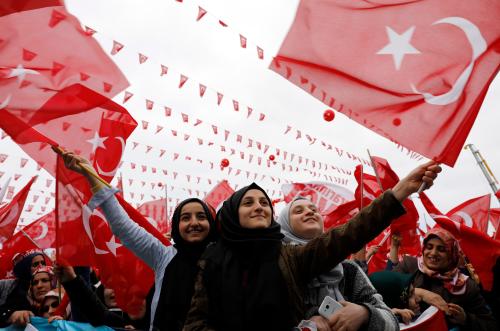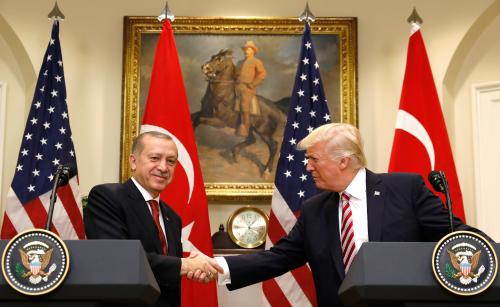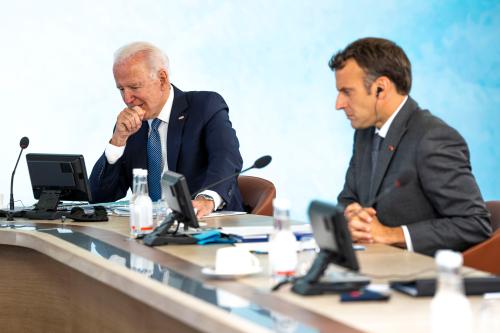This Sunday, the Turkish electorate will vote in a nationwide referendum on several proposed amendments to the constitution. This is Turkey’s seventh constitutional referendum since its transition from single-party rule to a multi-party system in 1946. The current constitution, which went into force in 1982, has already been amended three times by popular vote and 15 times through legislative action in the past 34 years.
After decades of amendments, 117 out of the 177 articles no longer stand in their original forms. The current package that will be put to a vote contains 18 measures that will further revise or repeal 76 articles. It is difficult to neatly categorize the proposed amendments, but below we group them into clusters, indicating how they will impact the functioning of the executive, legislative, and judicial branches, as well as democratic governance.
What might change?
What seems consistent across the board is that the amendments package has been prepared with current president Recep Tayyip Erdoğan in mind. Considering that both the Justice and Development Party (AKP) and Erdoğan are likely to continue to win the popular vote, the changes would institutionalize a populist, one-man system that jeopardizes legislative and judicial independence and consolidates them in the office of the president. Indeed, the dramatic changes proposed would set in motion the most drastic shake-up of the country’s politics and system of governance in its 94-year-long history. Indeed, as written in The Washington Post, Turkey would never be the same again if this is passed.
Executive branch: The president becoming stronger
The duties of the prime minister would be subsumed under the office of the president, and the prime ministry would be abolished, transforming the parliamentary system into a presidential one. Unlike under the current system, the president would not have to be neutral—above politics and representing the whole nation (article 7, amending article 101). The president would also be able to issue decrees on political, social, and economic issues that would carry the force of law (article 8, amending article 104). These three measures would accord substantial powers to the president, as the president would assume the powers of both the head of government and head of state, and the legislature could therefore become a rubber stamp on the executive.
However, there are a couple of loopholes that could derail this process. First of all, there would be limits on the scope of presidential decrees: they could not contradict the fundamental and civil rights and responsibilities enshrined in the constitution (articles 12, 13 and section IV). Furthermore, the president could not overturn existing laws or decree a law in an issue-area where law by the parliament is required. If a decree contradicts the law, the law takes precedence, and the parliament could pass laws that override presidential decrees.
It may seem as if the legislature could then function as a restraining mechanism on the president; yet, it all depends on its composition. A parliamentary session requires 1/3 of its members to be present to make decisions, and needs an absolute majority (50 percent + 1) of the members present to vote in favor of a decision (article 96). This means that, if the president’s party controls a critical number of seats, the legislature could indeed become a rubber stamp. If the president’s party does not have an absolute majority, however, the parliament could technically be in a position to overturn the president’s decree. The general assumption is that, for the foreseeable future, the AKP would be able to secure an absolute majority—meaning that the legislature would likely not move to contradict the executive anyway.
Moreover, under the proposed system, the president could dissolve the parliament, but with an interesting twist: Since presidential and general elections would be held every five years and simultaneously (article 4, amending Article 77), the dissolution of the parliament would then technically mean the dissolution of the presidency. The parliament could either be dissolved by itself (with a 3/5 majority) or by the president (article 11, amending article 116). If the parliament moved forward on such a decision in the president’s second term, the incumbent could win a third mandate. If the package passes, the new system will enter into force in 2019, when the parliament’s current term has ended. Erdoğan would then be able to stay at the helm until 2029, assuming he continues to win the popular vote, and if the parliament called for snap elections towards the end of his second term, his presidency could be extended until 2034. In that event, the current president would have been in power for more than three decades, a first in Turkish republican history.
If the president himself called for new elections in his second term, by contrast, he would not be able to serve a third term in office.
Another proposed amendment would allow the president to appoint one or multiple vice presidents—an office that does not exist under the 1982 constitution (article 10, amending article 106). The president would also have the power to establish and/or abolish ministries, appoint ministers and other senior officials—all of whom would operate without being subject to any legislative or judicial review, and would be accountable only to the president.
Legislative branch: The parliament losing power
The parliament’s traditional function as a check-and-balance mechanism on the executive would be reduced. It would no longer be tasked with overseeing the council of ministers (article 5, amending article 87). Members’ of parliament right to submit oral and written questions as a part of their auditing process would also be amended—with the MPs only allowed to put forward “written submission” (article 6, amending article 98) to the vice-presidents and the ministers, and not to the president. These would elevate the president above legislative scrutiny—a major and dramatic break from past practice.
Another change is that the parliament would need an absolute majority of its entire membership (50 percent + 1) to re-pass a bill that the president sent back to the parliament for reconsideration, whereas the current constitution allows the parliament to bypass the president’s objections by a simple majority of a quorum (article 16/C, amending article 89). This would diminish the body’s decisionmaking capacity, making it more difficult to move in a direction that is not sanctioned by the president.
The process of impeachment would also be conducted differently. The parliament could petition for an investigation into an alleged crime with an absolute majority; it would then need 3/5 backing to move forward with such a petition, instead of a simple majority. A 15-member commission would then be appointed to produce a report, which would need a 2/3 majority to be sent to the supreme court for a final review (article 9, amending article 105). As such, it would become much more cumbersome to take actions against the president.
Judicial branch: More political appointees
Under the current system, the president appoints four of the 22 members of the High Council of Judges and Prosecutors, a body responsible for appointing new judges and prosecutors as well as overseeing promotions. The revised system (article 14, amending article 159) would reduce the overall number to 13, and still require the president to appoint four members, while the parliament would appoint the remaining seven. These 11 members would be joined by the minister of justice and the minister’s deputy; since the amendment package also allows the president to handpick his ministers, six members of the Council would be basically presidential appointees.
The 17 members of the Constitutional Court would be reduced to 15 (article 16/D, amending Article 146/1). Otherwise, the composition of the court would remain the same, with 12 of its members being appointed by the president and three of them by parliament. The parliament would select its appointees to these two bodies in two rounds, with the higher bar for the former requiring 3/5 majority and the latter an absolute majority of the total number of MPs.
If the new system were to pass, therefore, the president would select 18 of the 28 top-ranking members of the judiciary. If the president’s party at least has a 3/5 majority in parliament, the judiciary may then be entirely aligned with the executive—or, effectively, the president himself. Undoubtedly, this would put a huge question mark on the independence of the judiciary, as it would not be subject to a parliamentary review process and report only to the president.
Will it pass?
The latest opinion polls suggest a neck-and-neck race. In an overview of 28 surveys, 12 of them predict a victory for “yes,” while eight suggest the “no” camp will win. There is also the question of undecided voters. Some suggest that they actually oppose the package, but are unwilling to openly say so because of the oppressive environment in Turkey today. Indeed, as reported in Turkish and Western media, there are mounting concerns over how fair the vote will really be: intimidation against the “no” campaign runs rampant, and with scores of journalists in jail, media has now come effectively under the government’s control, not to mention concerns regarding fraud at the ballot box.
Surveys do not always provide an accurate indication of what will unfurl on voting day. Yet, what is certain is that Turks will be voting in a referendum that will have more impact on their country’s future trajectory than any of the preceding referendums. If this series of amendments passes on April 16, it will institutionalize a version of an executive presidency—now billed as executive presidency alla turca—that will accord the president more powers and more independence from the check-and-balance mechanisms than any other Turkish leader since 1946.








Commentary
The Turkish constitutional referendum, explained
April 13, 2017